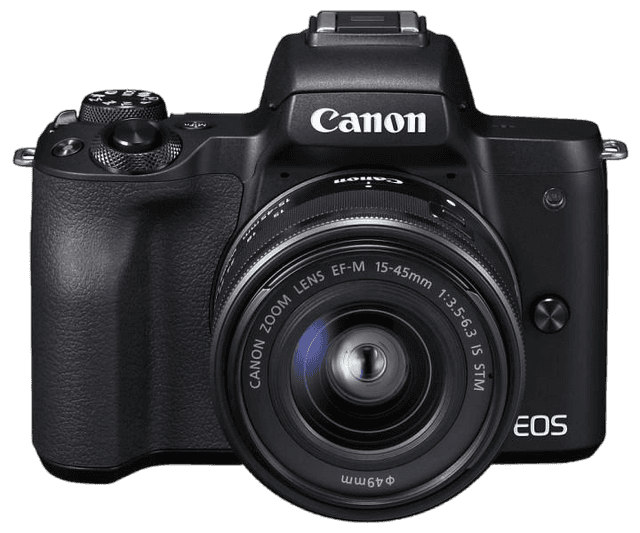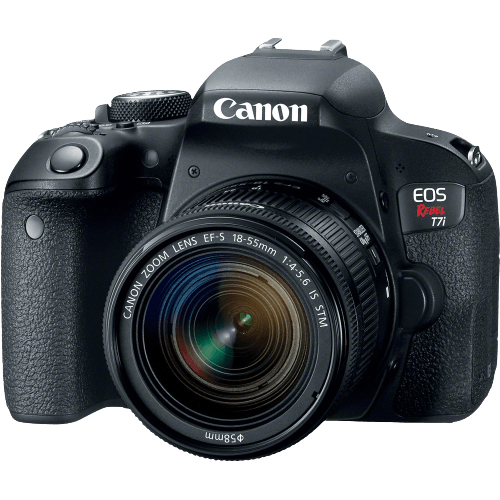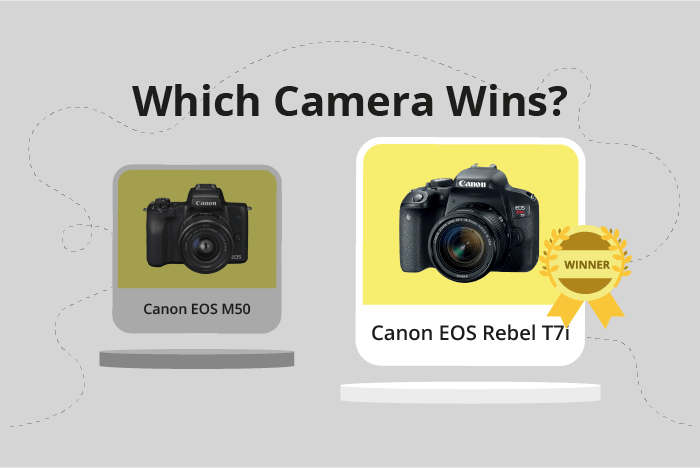Canon EOS M50 vs EOS Rebel T7i / 800D Comparison
Canon EOS M50

Canon EOS Rebel T7i / 800D

The Canon EOS Rebel T7i / 800D takes the lead with a score of 64/100, while the Canon EOS M50 trails slightly behind at 59/100. Both cameras share some common specifications, such as their announcement dates in 2017 and 2018, respectively, and their launch prices of $779.
The Rebel T7i / 800D, a DSLR camera, outperforms the M50 in certain aspects, possibly contributing to its higher score. On the other hand, the M50, a mirrorless camera, has its advantages as well. For instance, the M50 is lighter and more compact, weighing 390g and measuring 116 x 88 x 59mm, compared to the Rebel T7i / 800D’s 532g and 131 x 100 x 76mm dimensions.
Each camera has its strengths and weaknesses, and the final decision depends on the specific needs and preferences of the user.
Canon EOS M50 vs EOS Rebel T7i / 800D Overview and Optics
The Canon EOS Rebel T7i / 800D wins in the optics comparison with a score of 64/100, while the Canon EOS M50 scores 59/100. Both cameras share some common specifications, including 24 megapixels, CMOS sensor type, APS-C sensor size, and the absence of image stabilization.
The Rebel T7i / 800D outperforms the M50 in certain aspects. It has a higher DXOMARK sensor score of 79, compared to the M50’s 58, indicating better overall sensor performance. Additionally, the Rebel T7i / 800D features a more versatile Canon EF/EF-S lens mount, offering a wider range of lens compatibility.
On the other hand, the M50 has some advantages over the Rebel T7i / 800D. It possesses a faster shooting speed of 10 frames per second, compared to the Rebel T7i / 800D’s 6 frames per second. This makes the M50 better suited for capturing fast-moving subjects. The M50 also has a more advanced processor, the Digic 8, which contributes to its faster shooting speed and improved overall performance.
In terms of optics, the Rebel T7i / 800D is the better choice due to its superior sensor performance and greater lens compatibility. However, the M50’s faster shooting speed and more advanced processor make it a suitable option for those mainly focusing on action photography. Ultimately, the choice between these two cameras depends on the specific needs and preferences of the photographer.
Canon EOS M50 vs EOS Rebel T7i / 800D Video Performance
The Canon EOS M50 outperforms the Canon EOS Rebel T7i / 800D in video capabilities with a video score of 91/100, a 21-point lead over the T7i’s 70/100. Both cameras share some common features, including built-in time-lapse functionality. However, the M50 surpasses the T7i in several aspects, while the T7i has limited advantages in this comparison.
The M50 boasts a maximum video resolution of 4K (3840 x 2160), significantly higher than the T7i’s Full HD (1920 x 1080) resolution. This results in sharper and more detailed videos from the M50. Additionally, the M50 supports a maximum video frame rate of 120fps, allowing for smoother slow-motion footage, compared to the T7i’s 60fps limit.
On the other hand, the T7i does not offer any significant video advantages over the M50. Both cameras possess time-lapse functionality, but the M50’s higher resolution and frame rate make it a superior choice for producing time-lapse videos as well.
In comparing the video capabilities of the Canon EOS M50 and Canon EOS Rebel T7i / 800D, it is evident that the M50 is the stronger contender. Its higher video resolution and frame rate provide users with more detailed and smoother footage. The T7i’s only shared advantage is the time-lapse functionality, but the M50’s superior specs make it the clear winner in this category.
Canon EOS M50 vs EOS Rebel T7i / 800D Features and Benefits
The Canon EOS M50 and the Canon EOS Rebel T7i/800D both have a feature score of 70/100, making it a tie in this comparison. These cameras share many specifications, such as a 3-inch screen size, 1,040,000-dot screen resolution, touchscreen capability, flip screen, WIFI, and Bluetooth connectivity. The similarities in these features indicate that both cameras offer a comparable user experience.
However, the Canon EOS Rebel T7i/800D has an advantage over the Canon EOS M50, as it includes GPS functionality. This feature allows users to geotag their images, which can be useful for organizing and locating photos based on their capture location. This added feature contributes to the Canon EOS Rebel T7i/800D’s overall appeal.
On the other hand, the Canon EOS M50 does not offer any notable advantages over the Canon EOS Rebel T7i/800D in terms of features. Both cameras provide the same level of performance and user experience in this aspect.
Taking all these factors into account, it is evident that the Canon EOS Rebel T7i/800D holds a slight edge over the Canon EOS M50 due to its GPS functionality. This additional feature can be beneficial for users who value geotagging capabilities. However, the overall user experience is quite similar for both cameras, as they share many key specifications. Therefore, potential buyers should consider their specific needs and preferences when choosing between these two models.
Canon EOS M50 vs EOS Rebel T7i / 800D Storage and Battery
The Canon EOS Rebel T7i / 800D outperforms the Canon EOS M50 in storage and battery, scoring 29 points compared to the M50’s 13 points. Both cameras share common specifications, such as having one memory card slot and compatibility with SD, SDHC, and SDXC (UHS-I) memory cards. Neither camera offers USB charging.
The Rebel T7i / 800D excels in battery life, providing 600 shots per charge using the LP-E17 battery. In contrast, the M50 only delivers 235 shots per charge with its LP-E12 battery. This significant difference in battery life makes the Rebel T7i / 800D a more reliable choice for extended shooting sessions.
While the M50 does not surpass the Rebel T7i / 800D in storage and battery capabilities, it remains a capable camera in other aspects. However, considering only storage and battery performance, the Rebel T7i / 800D stands as the superior option, providing longer battery life and identical storage options.
Alternatives to the Canon EOS M50 and EOS Rebel T7i / 800D
Are you still undecided about which camera is right for you? Have a look at these popular comparisons that feature the Canon EOS M50 or the Canon EOS Rebel T7i / 800D:

